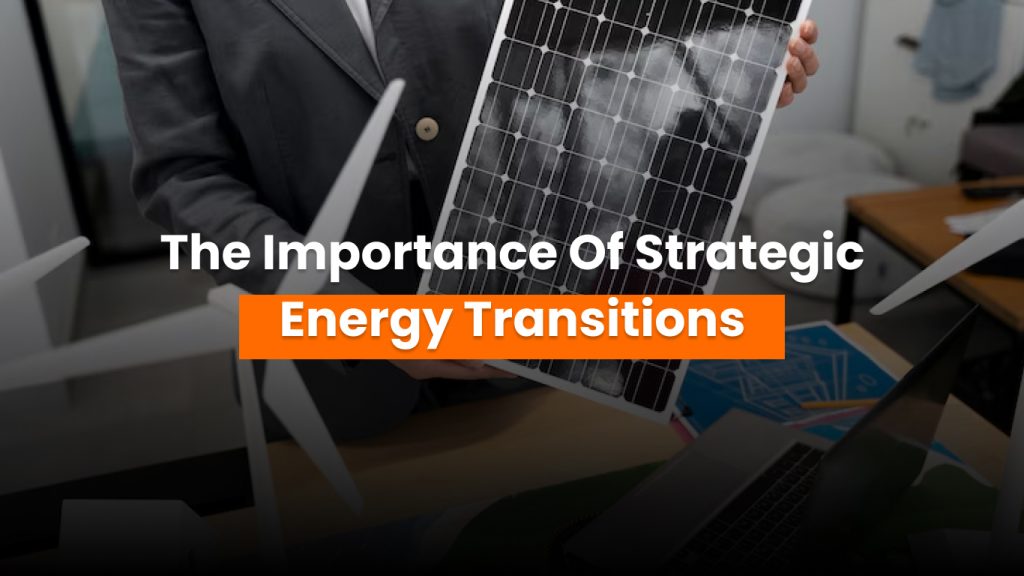Introduction:
The global push toward cleaner energy is accelerating, and businesses need a strategic energy transition plan to keep up. A strategic energy transition means taking a long-term, proactive approach to shift from fossil fuels to sustainable energy sources. This isn’t just about installing a few solar panels – it’s about crafting an integrated strategy for power generation, storage, and consumption that will carry your organization into the future. Companies that plan their transition carefully stand to gain major benefits: more stable energy costs, improved resilience against outages, and alignment with climate goals. In fact, an overwhelming 97% of executives now say they support a clean energy transition for their businesses. Let’s explore why strategic energy transitions are so important and how battery storage in particular plays a key role.
What Is a Strategic Energy Transition?
A strategic energy transition is essentially a roadmap for how your business will evolve its energy usage over time. Instead of reacting to crises like fuel price spikes or new carbon regulations, you plan ahead to adopt renewable energy, improve efficiency, and phase out reliance on fossil fuels. This might involve setting targets (for example, getting 50% of power from renewable sources by 2030), investing in clean energy projects, and upgrading infrastructure. The importance of having a strategy is clear: it enables businesses to control their energy destiny and avoid being caught off-guard by market or policy changes. Nearly all companies (99%) now set formal energy goals focused on increasing carbon-free energy and cutting emissions. In other words, the vast majority of businesses recognize that a planned transition isn’t just nice to have – it’s becoming essential for long-term success. By mapping out steps like solar installations, fleet electrification, or facility upgrades, you can move steadily toward a cleaner and more reliable energy profile.
Benefits of a Planned Energy Transition
Taking a strategic approach to energy offers several concrete benefits. First, it provides cost stability and savings. Renewable energy (like solar and wind) often has lower lifetime costs than fossil energy and isn’t subject to fuel price volatility. By locking in clean energy sources, businesses can hedge against rising utility rates. Many companies are finding that investments in efficiency and renewables pay for themselves through lower monthly bills. Second, a transition plan boosts resilience. Diversifying your energy mix with on-site generation and backup storage makes your operations less vulnerable to grid outages or fuel supply disruptions. If the grid goes down, having solar panels plus battery backup means your critical systems stay online. Third, it helps ensure regulatory compliance and brand reputation. Governments worldwide are instituting climate targets and incentives; businesses that transition early can capitalize on tax credits and avoid potential penalties. Demonstrating leadership in sustainability can also strengthen your brand with customers, investors, and employees who increasingly value climate responsibility. Finally, strategic transitions unlock competitive advantage. Companies with lower energy costs and greener operations are often more agile and attractive in the marketplace. By planning ahead, you position your business to thrive in the emerging clean energy economy, rather than scrambling to adapt later.
The Role of Battery Storage in Energy Transitions
Among all the tools available, battery energy storage stands out as a key enabler of the clean energy transition. Battery storage systems allow you to capture energy when it’s abundant and cheap – for instance, storing excess solar power generated at midday – and use it when you actually need it. This capability fundamentally changes what is possible in an energy strategy. Batteries provide the missing piece that makes renewable energy a truly reliable resource. Solar and wind are intermittent by nature, but with batteries, their energy can be banked for use anytime. In practical terms, battery storage brings multiple benefits: it adds resiliency by supplying power during outages or peak demand spikes, it helps balance and diversify your energy portfolio, and it can even generate revenue by providing grid services. For example, a business could charge its batteries with solar power on a sunny day and then draw from those batteries in the evening to avoid expensive peak electricity rates. By doing so, the company cuts costs and eases strain on the grid. Battery systems can also be configured to kick in immediately if the grid fails, keeping critical operations running. Essentially, battery storage allows renewables to do more – it supplements solar or wind projects with the added reliability of stored energy, making your overall energy supply more resilient and flexible. This is why so many organizations are now deploying batteries as part of their transition. Around two-thirds of businesses plan to invest in on-site generation and battery storage within the next three years, underscoring how vital storage has become for corporate energy strategies.
Implementing Your Transition Plan
To get started with a strategic energy transition, it’s important to assess your current energy baseline and identify the most impactful opportunities. Many companies begin with “low-hanging fruit” like energy efficiency improvements (LED lighting, efficient HVAC systems, smart controls) to reduce demand. Simultaneously, you can explore renewable energy options – for instance, installing your own solar array or subscribing to a local solar farm. Tools like complete solar power systems are now available that bundle panels, inverters, and battery storage into integrated solutions for businesses. Partnering with experienced energy consultants or solution providers can help in designing a roadmap tailored to your operations and goals. They might conduct an energy audit and then recommend a mix of on-site generation, battery capacity, and necessary grid purchases to optimize both cost and reliability. It’s also wise to set interim milestones (e.g., 25% renewable by 2025, 50% by 2030) so you can track progress and adjust as needed. And don’t forget to engage stakeholders – from facility managers to finance teams – to ensure the plan is realistic and supported across the organization. With a clear plan, you can then phase in projects over time, taking advantage of incentives and technological improvements along the way. The key is to treat energy transition as a core business strategy, not a one-off project. By continuously evolving and investing according to your plan, your company will steadily reduce its carbon footprint and energy risk exposure.
Conclusion:
Embracing a strategic energy transition is no longer optional – it’s a smart business move in the face of climate change and evolving energy markets. A well-crafted transition plan helps you navigate the shift to renewables on your own terms, reaping benefits like cost savings, improved resilience, and a stronger corporate reputation. Crucially, integrating battery storage into your strategy amplifies these benefits by ensuring you have power when and where you need it, regardless of the grid’s status. Companies worldwide are taking this to heart: nearly 93% of business leaders are considering investments in on-site renewables and storage to power their operations. By planning your energy future now, you position your business to be a leader in the clean energy era – with reliable power, controlled costs, and the goodwill that comes from doing the right thing. The sooner you start mapping your energy transition, the better prepared you’ll be to secure a sustainable and prosperous future.




